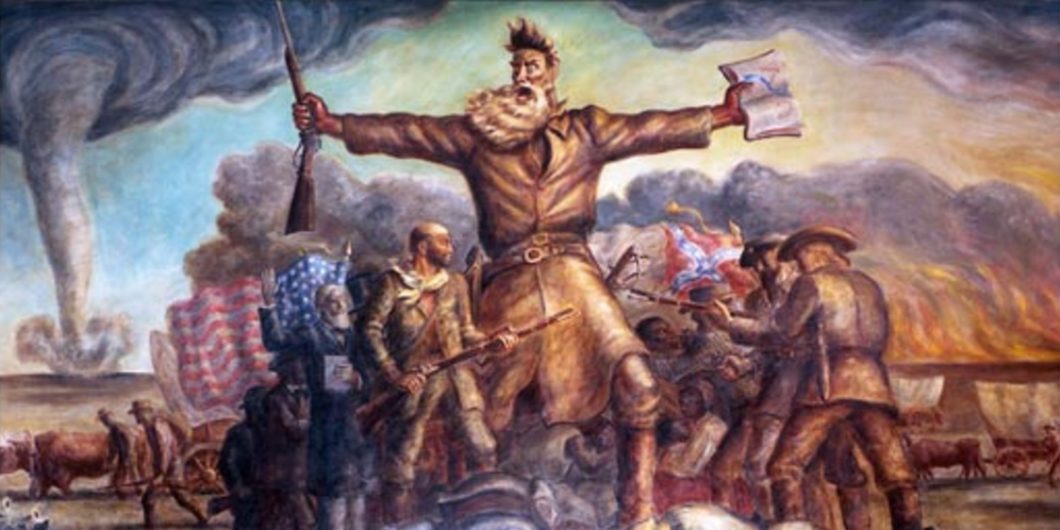Two Paths to Abolition
At the heart of H.W. Brands’ dual biography of John Brown and Abraham Lincoln is the question: “How does a good man challenge a great evil?” This is a problem that continues to vex politicians, pundits, and activists from all across the political spectrum, and many of the responses have remained the same in the age of Trump as they were in the age of Lincoln. Brown and Lincoln have been put into dialogue by historians before, representing conflicting means of attaining the shared vision of a United States rid of slavery. Likewise, at different times in U.S. history, Brown’s and Lincoln’s approaches have drawn applause and criticism from different sides within American politics. Given the current political and racial climate, as well as the public infighting between the political parties and their bases, The Zealot and the Emancipator is an incredibly timely work.
What propels much of the book is Brown’s and Lincoln’s differing and dueling approaches to the pursuit of ending slavery. Since these two might be viewed as fellows in the same fight, Brands teases out the differences between the pair, along with a whole host of other antislavery movers and shakers. While political throwdowns between proslavery and antislavery figures should come as no surprise, Brands offers a narrative of how allied advocates and like-minded politicians can be the source of some of the most heated and embittered debates and rivalries. Though Brown and Lincoln never knew one another, nor had any contact, Brands presents them as the representatives of a much deeper struggle to shape the future of antislavery policy and politics. One chose uncompromising vigilantism (or even terrorism) while the other chose elected office, professional politics, and legal remedies.
Abolitionist Origins
Brown didn’t begin life as the radical we know him as today. As Brands details, Brown went from a steadfast but practically minded critic of slavery to an uncompromising advocate of immediate emancipation. In 1834 Brown wrote, “I have been trying to devise some means whereby I might do something in a practical way for my poor fellow-men who are in bondage.” Brown mused that this could take the form of the adoption of black children into his already large family or perhaps the opening of a school for former slaves. He even contemplated purchasing a slave, if only to buy that person’s freedom, though none of these plans came to pass. But by 1837 Brown would declare, “Here before God, in the presence of these witnesses, from this time, I consecrate my life to the destruction of slavery.” From there onward, Brands chronicles Brown’s exploits across the country, zeroing in on the events of Bleeding Kansas and his demise following the failed raid on Harpers Ferry.
Brands likewise conveys Lincoln’s antislavery origin story, beginning with his father’s influence and his early life in Kentucky and then Indiana. In New Orleans, Lincoln witnessed first-hand the buying and selling of human beings. As Brands writes, a considerable amount of hagiography concerning this event has since developed, but nonetheless, such horrific scenes most likely “simply confirmed the distaste he already felt” towards slavery. But beyond the inhumane treatment of black people, Lincoln’s opposition to slavery was also underpinned by how the slave system would negatively affect the wages and conditions of white people. From there Brands recounts Lincoln’s early forays into law and politics, of which the Lincoln-Douglas debates became the centerpiece.
While Brands places Brown and Lincoln at the center of his antislavery drama, he also highlights the numerous other figures who offered their criticisms of the “peculiar institution,” as well as their opinions on how its destruction should come about. William Lloyd Garrison, Elijah P. Lovejoy, Harriet Beecher Stowe, and numerous others come under consideration. Frederick Douglass rightly receives a great deal of attention, which is more than proper given that he knew the horrors of slavery, rubbed shoulders with some of the most famous antislavery voices, and met both Brown and Lincoln. Because of this, Douglass brings out the most complex elements within these debates concerning how best to confront slavery. For example, Brands details the back-and-forth between Brown and Douglass during their conversation about the instigation of a full-scale southern slave rebellion. Both theorize what might happen if such a course of action were to be taken, arguing how the slaves would respond and what their enslavers might do in retaliation. Douglass believed a less violent path was possible while Brown saw no alternative. With life or death on the line, it is a fascinating example of dissent between personal friends and allied advocates.
Lincoln viewed radical abolitionists like Brown as a danger, not only because of their more violent methods, but also because such actions would harden the slaveholders’ line, engross sympathy for them, and risk fracturing the already tenuous Union.
Brands does not shy away from or underplay the most violent aspects of Brown’s antislavery activities. In recounting the Pottawatomie massacre, the Battle of Black Jack, the Battle of Osawatomie, and other elements that now make up what we know as “Bleeding Kansas,” as well as the raid on Harpers Ferry, Brands teases out the more complex and uncomfortable elements of Brown’s legacy. In trying to capture this difficult legacy, David Blight quipped that John Brown was “a terrorist on the right side of history,” a descriptor that might also apply to Brands’ characterization. But beyond Brown’s own actions, Brands also brings forth striking historical details about Brown’s perception of himself and his enemies’ perceptions of him. Notably, Brown tried to downplay his part in the execution of slavery-sympathizers and his intentions to lead an armed slave revolt. His enemies, in contrast, exaggerated his capabilities as well as his deeds. While Brown’s personal story climaxes halfway through the book, his specter still haunts much of the second half, both as a source of condemnation against so-called “Black Republicans” as well as an inspiration, as evidenced in the song “John Brown’s Body.”
Vigilantism or Politics?
Throughout the book, Brands helpfully captures the sense of consensus among northerners, particularly religious reformers and Republicans, that slavery was a moral evil and needed to come to an end. But on how such a feat should be achieved, whether former slaveholders should be compensated, and what should be done with formerly enslaved people, there was no consensus. As Lincoln publicly wrestled, “If all earthly power were given me, I should not know what to do, as to the existing institution [of slavery].” As such, a common theme teased out by Brands is how historical actors grapple with political realities whilst aiming to change American culture, society, and legislation. As the old saying goes, “politics is the art of the possible, the attainable,” and this attitude is best embodied by Lincoln within Brands’ narrative. Brown, on the other hand, saw such sentiments and politicking as merely seeking out the path of least resistance.
Brown viewed the politicking adopted by figures like Lincoln and the Republicans, as well as antislavery Democrats, as little better than making a deal with the devil, and a false choice between the lesser of two evils. Lincoln, on the other hand, viewed radical abolitionists like Brown as a danger, not only because of their more violent methods, but also because his actions would harden the slaveholders’ line, engross sympathy for them, and risk fracturing the already tenuous Union.
While everyone today might wish to imagine themselves as an abolitionist, Brands’ narrative is a stark reminder of the clashing kinds of antislavery activism, as well as the differing costs associated with them. Given these various forms of antislavery, the question naturally becomes, who was more effective? The idealistic but destructive John Brown or the politically cunning but often compromised Abraham Lincoln? Perhaps wisely, or in an effort to be ambiguous, Brands’ narrative does not offer much by way of an answer, and this will no doubt give readers the ability to pick one over the other. With this in mind, it is worth remembering the words of Arthur M. Schlesinger Jr. that, “Self-righteousness in retrospect is easy—also cheap.”
Despite recent efforts to challenge the sincerity of Lincoln’s antislavery principles, Brands maintains that Honest Abe truly opposed slavery. Being a professional politician, nervous about alienating voters, angering his base, and scaring off antislavery but Democrat-inclined voters, Lincoln operated in a political arena detested by abolitionists like Brown, showcasing his efforts to minimize the South’s influence and to halt the spread of slavery. But due to this constantly changing partisan tightrope, Brands explains how people supportive of Lincoln could view him as both too radical and too conservative on the slavery question. But Brands does not dive very deeply into how Lincoln’s opposition toward slavery evolved and hardened over time, nor does Brands truly capture the antislavery sentiment underpinning the ideology of the young Republican Party. Even so, Brands presents Lincoln’s undisputable antislavery commitment as cautious but practical, negotiable but determined.
Sadly, Brands also fails to unpack and explore the depths and complexities of Brown’s religious convictions. Although Brands describes Brown as a “zealot” against slavery, he does not explain what Brown’s antislavery theology entailed. The book is padded with Brown’s references to God and Satan as well as the odd Bible passage, but Brands does not take the opportunity to flesh out their meaning for Brown’s worldview. This lack of religious contextualization is a shame because Brands does a fine job painting Brown’s political and cultural context. Curious readers would do well to seek out Louis A. DeCaro Jr.’s brilliant religious biography, “Fire From the Midst of You”: A Religious Life of John Brown.
Given the present political climate, one cannot help but find parallels, lessons, and warnings in The Zealot and the Emancipator. Many of its moments certainly have echoes with our own: Frustration with the constitutional order, dissatisfaction with the two reigning political parties, threats of refusing to acknowledge the outcome of the presidential election, outbursts of political violence, pleas for law and order, and shocking scenes of racial injustice. Because of this, calls for reform and demands for change can be heard loudly and clearly. But Brands’ most recent work is a formidable reminder that just because a major faction of the American people believe change is necessary does not mean they are united on how that change might come about. While Lincoln’s style of politics ultimately proved victorious in the 19th century, one cannot help but wonder if it will win the day in our current moment.


